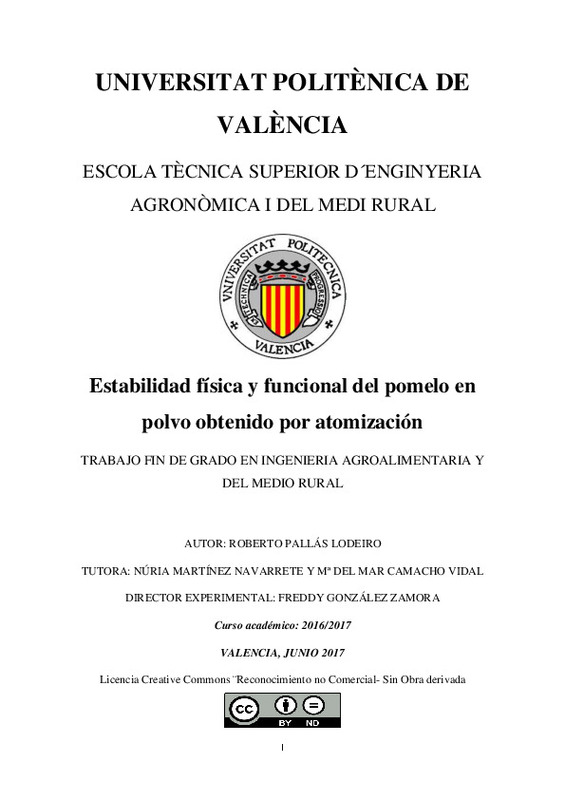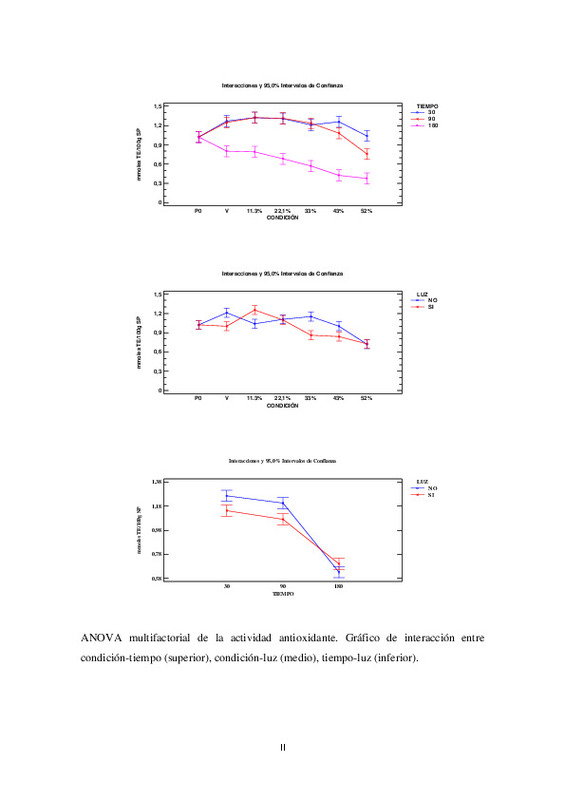JavaScript is disabled for your browser. Some features of this site may not work without it.
Buscar en RiuNet
Listar
Mi cuenta
Estadísticas
Ayuda RiuNet
Admin. UPV
Estabilidad física y funcional del pomelo en polvo obtenido por atomización
Mostrar el registro sencillo del ítem
Ficheros en el ítem
| dc.contributor.advisor | Camacho Vidal, Mª Mar
|
es_ES |
| dc.contributor.advisor | Martínez Navarrete, Nuria
|
es_ES |
| dc.contributor.advisor | González Zamora, Freddy
|
es_ES |
| dc.contributor.author | Pallás Lodeiro, Roberto
|
es_ES |
| dc.date.accessioned | 2017-07-21T10:52:47Z | |
| dc.date.available | 2017-07-21T10:52:47Z | |
| dc.date.created | 2017-07-05 | |
| dc.date.issued | 2017-07-21 | es_ES |
| dc.identifier.uri | http://hdl.handle.net/10251/85610 | |
| dc.description.abstract | [ES] La atomización permite la obtención de alimentos en polvo de muy alta calidad. Las frutas son alimentos de alto valor funcional, principalmente debido a la capacidad antioxidante que presentan algunos de sus compuestos como las vitaminas y fitoquímicos. No obstante, se trata de alimentos muy perecederos debido a su alto contenido en agua, lo que limita su consumo. El formato de fruta deshidratada en polvo aumenta la vida útil del producto, además de ofrecer otras ventajas relacionadas con el menor espacio necesario para su transporte y almacenamiento. En la medida en que el proceso utilizado para la obtención del polvo mantenga estable la calidad de la fruta, incluido su valor funcional, ésta podría ser otra forma de ofrecer fruta al consumidor. En este trabajo se ha estudiado la estabilidad del pomelo en polvo obtenido por atomización en cuanto a su fluidez, color y capacidad antioxidante. Para ello se ha analizado la evolución de estas propiedades en función de la humedad relativa del ambiente al que está expuesto el producto y de la presencia o ausencia de luz y oxígeno. El color se ha medido a través de las coordenadas CIE L*a*b*, las propiedades mecánicas mediante un ensayo de compresión y la capacidad antioxidante por el método del DPPH. Los resultados obtenidos permiten establecer que para asegurar la estabilidad del pomelo en polvo durante su almacenamiento conviene envasarlo a vacío o en envases que aseguren una humedad relativa en su interior inferior al 20 %, sin necesidad de que el envase sea opaco. En estas condiciones, en seis meses, el producto se mantiene suelto y su color es aceptable, siendo la pérdida de su capacidad antioxidante en torno al 26 %. | es_ES |
| dc.description.abstract | [EN] Spray drying allows obtaining powdered foods of very high quality. Fruits are foods of high functional value, mainly due to the antioxidant capacity of some of their compounds such as vitamins and phytochemicals. However, they are very perishable foods because of their high water content, which limits their consumption. The format of powdered fruit increases the shelf life of the product, besides offering other advantages related to the smaller space necessary for its transport and storage. To the extent that the process used to obtain the powder maintains a stable fruit quality, including its functional value, this could be another way of offering fruit to the consumer. In this work, the stability of powdered grapefruit obtained by atomization in terms of its color, flowability and antioxidant capacity have been studied. For this purpose, the evolution of these properties was analysed as a function of the relative humidity of the environment to which the product is exposed and of the presence or absence of light and oxygen. The color was measured through the CIE L*a*b* coordinates, the mechanical properties by a compression test and the antioxidant capacity by the DPPH method. The obtained results allow us to establish that in order to ensure the stability of the powdered grapefruit during its storage, it is advisable to pack it at vacuum or in packages that ensure a relative humidity of less than 20% inside it, without the need for the package to be opaque. Under these conditions, in six months, the product remains as a free flowing powder and its color is acceptable, with a loss of its antioxidant capacity at around 26%. | es_ES |
| dc.format.extent | 38 | es_ES |
| dc.language | Español | es_ES |
| dc.publisher | Universitat Politècnica de València | es_ES |
| dc.rights | Reconocimiento - Sin obra derivada (by-nd) | es_ES |
| dc.subject | Spray drying | es_ES |
| dc.subject | Antioxidant activity | es_ES |
| dc.subject | Mechanical properties | es_ES |
| dc.subject | Storage | es_ES |
| dc.subject | Atomización | es_ES |
| dc.subject | Actividad antioxidante | es_ES |
| dc.subject | Propiedades mecánicas | es_ES |
| dc.subject | Color | es_ES |
| dc.subject | Almacenamiento | es_ES |
| dc.subject.classification | TECNOLOGIA DE ALIMENTOS | es_ES |
| dc.subject.other | Grado en Ingeniería Agroalimentaria y del Medio Rural-Grau en Enginyeria Agroalimentària i del Medi Rural | es_ES |
| dc.title | Estabilidad física y funcional del pomelo en polvo obtenido por atomización | es_ES |
| dc.type | Proyecto/Trabajo fin de carrera/grado | es_ES |
| dc.rights.accessRights | Abierto | es_ES |
| dc.contributor.affiliation | Universitat Politècnica de València. Escuela Técnica Superior de Ingeniería Agronómica y del Medio Natural - Escola Tècnica Superior d'Enginyeria Agronòmica i del Medi Natural | es_ES |
| dc.contributor.affiliation | Universitat Politècnica de València. Departamento de Tecnología de Alimentos - Departament de Tecnologia d'Aliments | es_ES |
| dc.description.bibliographicCitation | Pallás Lodeiro, R. (2017). Estabilidad física y funcional del pomelo en polvo obtenido por atomización. http://hdl.handle.net/10251/85610. | es_ES |
| dc.description.accrualMethod | TFGM | es_ES |
| dc.relation.pasarela | TFGM\68506 | es_ES |
Este ítem aparece en la(s) siguiente(s) colección(ones)
-
ETSIAMN - Trabajos académicos [3541]
Escuela Técnica Superior de Ingeniería Agronómica y del Medio Natural







